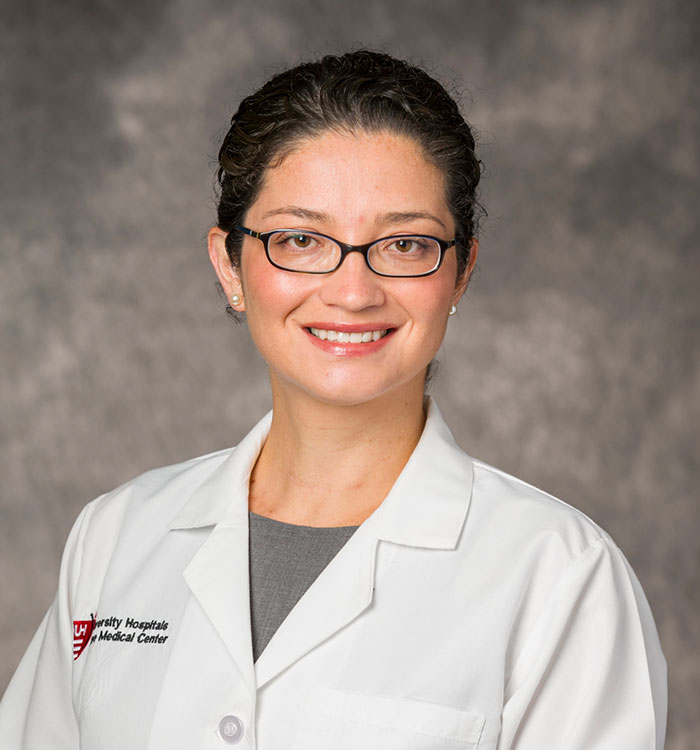Innovations in Venous Care
December 06, 2023
Innovations in Cardiovascular Medicine & Surgery | Fall 2023
Founded in 2021, the Center for Comprehensive Venous Care (CCVC) within University Hospitals Harrington Heart & Vascular Institute continues expanding its advanced venous services.
 Karem Harth, MD, MHS
Karem Harth, MD, MHS
“When patients come through our tertiary care center, they receive a thorough evaluation of their entire venous system before we prescribe a treatment algorithm,” says Karem Harth, MD, MHS, Director of the CCVC at UH Harrington Heart & Vascular Institute. “We strive to be at the forefront of emerging therapies, improve quality-of-life for our patients and advancing academic venous medicine.”
Dr. Harth highlights some of the center’s recent initiatives.
Trial of Implantable Femoral Valve for Chronic Venous Insufficiency
University Hospitals Cleveland Medical Center is the only site in Northeast Ohio and one of 20 nationwide participating in the Surgical Anti-reflux Venous Valve Endoprosthesis (SAVVE®) trial. The pivotal study is evaluating VenoValve®, an implantable bioprosthetic venous valve, to establish deep vein competence for post-thrombotic syndrome.
“The surgically implantable femoral valve treats deep venous reflux in patients with advanced disease, ulcers or significant skin breakdown,” says Dr. Harth. “We have been able to recruit patients and are in the active phase of the study.”
The fully enrolled SAVVE trial aims to determine whether VenoValve is safe and effective in patients with severe chronic vein insufficiency (CVI) who have failed three months of standard care. “We have seen that the implantable valve reduces reflux to the point where it is almost undetectable,” says Dr. Harth. “Early results have been encouraging, and we are excited that University Hospitals is able to offer frontline access to this novel treatment.”
New Stent Trial for Pelvic Vein Thrombosis
The Institutional Review Boards (IRB) phase is complete for an upcoming trial of a new deep venous stent. The GORE® VIAFORT Vascular Stent Iliofemoral Study is a multicenter clinical trial of the performance, safety and efficacy of an investigational treatment for symptomatic inferior vena cava (IVC) obstruction with or without combined iliofemoral obstruction in adult patients.
University Hospitals Cleveland Medical Center is one of up to 25 sites nationwide that will be recruiting patients. “This is a new device from Gore to address treatable conditions in the pelvic veins and IVC such as occlusions or narrowing,” says Dr. Harth. Several Food and Drug Administration (FDA)-approved venous stents have come to market since 2019. “This latest investigational stent has a special PTFE [polytetrafluoroethylene] coating around the interstices and is thought to be more flexible and take turns better in the pelvis where most of these stents are placed,” she says. “It will be exciting to see if we can improve outcomes with this new device.”
Advancements in Venous Ablation
Radiofrequency ablation (RFA) is an image-guided, minimally invasive procedure to treat superficial venous insufficiency in the legs. Utilizing a radiofrequency catheter with a heating tip at its end, the surgeon employs thermal energy to destroy the endothelium of the diseased superficial veins. Traditionally, the technique has required a 7 French catheter. Now, there is a smaller 6 French catheter with a slightly longer heating element.
“In our initial experience, the 6 French is a bit more flexible,” says Dr. Harth. “It results in a smaller puncture and can treat areas that may be challenging to access because of extensive damage or prior blood clots.” For example, phlebitis can cause scarring in the vein. The smaller catheter may offer easier maneuverability in treating these conditions. “RFA has excellent closure rates, and this advancement is a revised tool to treat complex venous insufficiency successfully,” she says.
Addressing Diversity of Venous Ulceration and Disparity of Care Access
In collaboration with UH Vascular Surgery Fellow Joshua Burk, MD, Dr. Harth penned an invited commentary for the Journal of Vascular Surgery’s Venous and Lymphatic Disorders (JVS-VL). The surgeons’ publication is a response to Characteristics of Venous Leg Ulcer Patients at a Tertiary Wound Care Center by Alyssa Klein and Eri Fukava.
In their commentary, Drs. Harth and Burk acknowledge the variability of risk factors, demographics and anatomical patterns that must be addressed when treating venous leg ulcers (VLUs). Not every venous patient is the same or has the same access to leading therapies.
“Venous disease is often viewed as fairly straightforward, but multiple layers of complexity need to be considered,” says Dr. Harth. “It is important to tailor care to the anatomic diversity of the patient and improve equity in care access.”
For more information on comprehensive venous care or to refer a patient, contact Dr. Harth’s office at 216-844-3013 or Karem.Harth@UHhospitals.org.
Contributing Expert:
Karem Harth, MD, MHS
Director, Center for Comprehensive Venous Care
Co-Medical Director, Vascular Laboratories
University Hospitals Harrington Heart & Vascular Institute
Associate Professor
Case Western Reserve University School of Medicine


